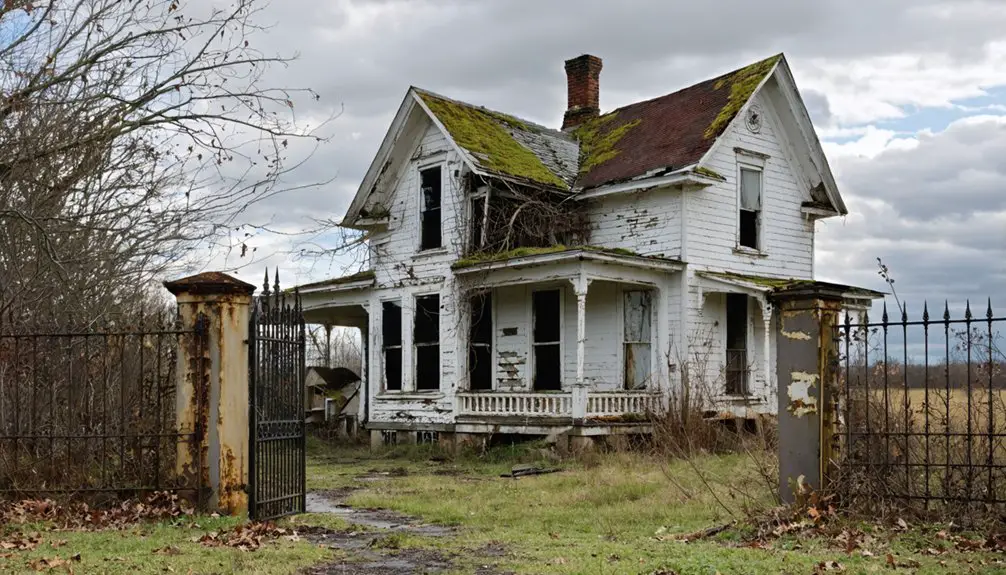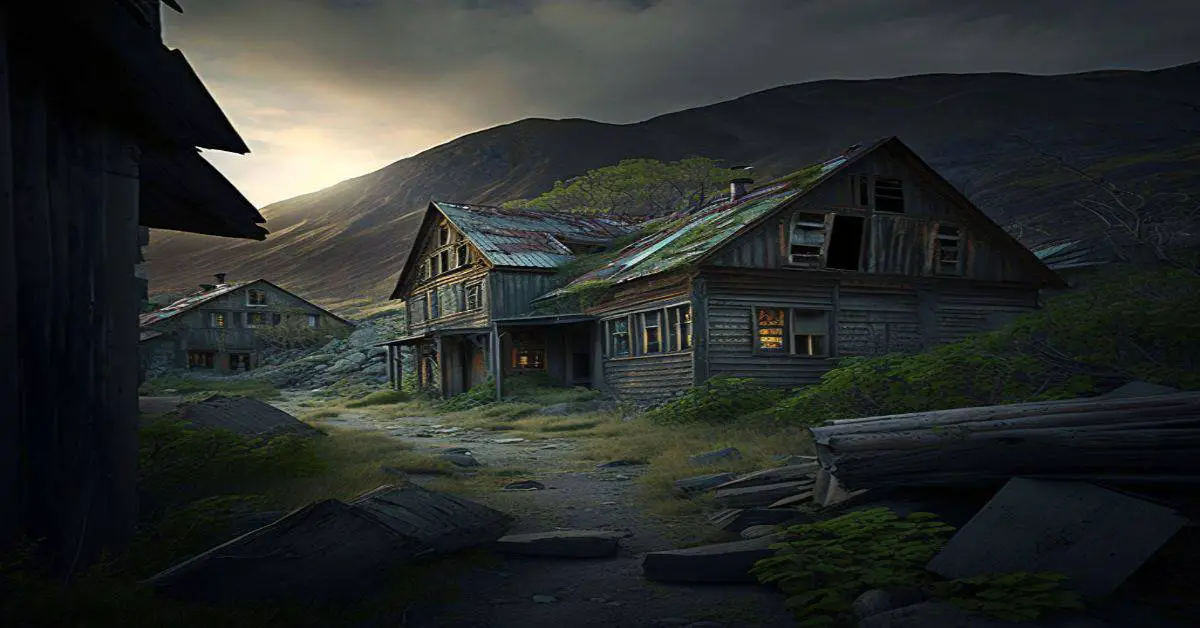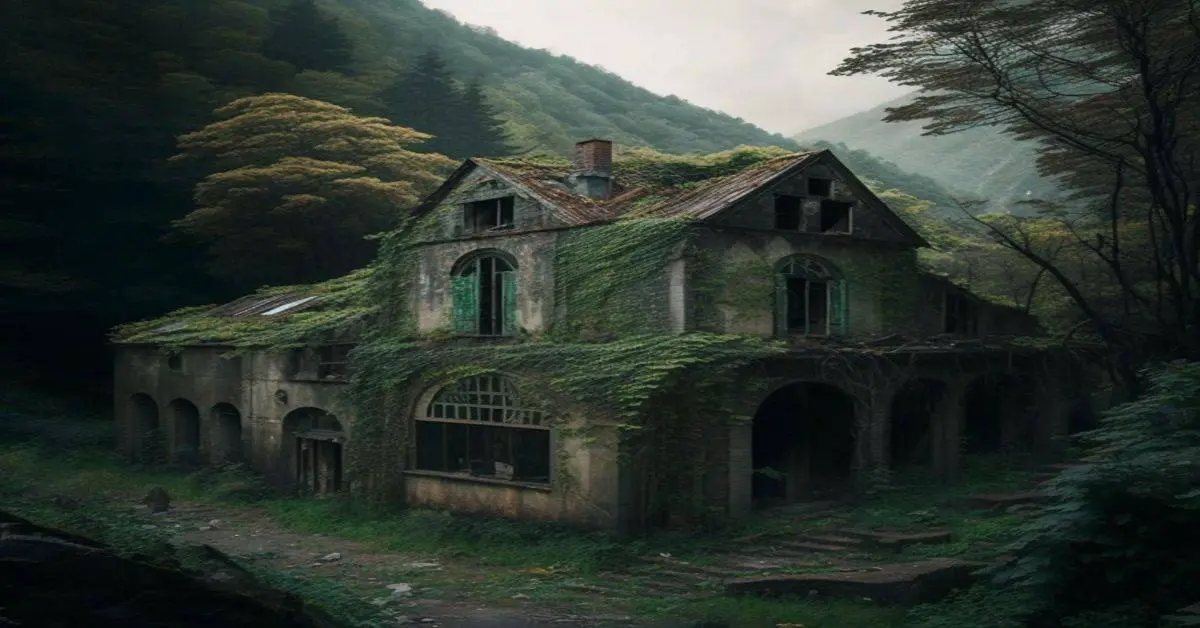You’ll discover Jacktown, a ghost town in Michigan’s Leelanau County, nestled along the former Empire & Southeastern Railroad line. This early 1900s timber town flourished as an essential railway junction, with the Hall and Buell Lumber Company driving its prosperity. The historic Bland Cemetery, established in 1868, marks the town’s location and contains 18 burials from Jacktown’s heyday. After timber resources depleted in the 1920s, the community faded, leaving behind fascinating traces of Michigan’s lumber era.
Key Takeaways
- Jacktown was a lumber-based ghost town in Leelanau County, Michigan, established in the early 1900s along the Empire & Southeastern Railroad line.
- The town flourished during Michigan’s timber boom but was abandoned in the 1920s after local timber resources were depleted.
- Bland Cemetery, established in 1868, remains a key landmark with 18 burials and serves as a historical record of the community.
- The site is accessible via State Road 677 and County Line Road, though visitors should prepare for rough terrain and poor cell service.
- Hall and Buell Lumber Company dominated local operations during Jacktown’s peak, operating advanced band saw mills for timber processing.
The Railroad Town’s Birth
Nestled along the Empire & Southeastern Railroad line in Leelanau County, Michigan, Jacktown emerged in the early 1900s as an essential hub for the region’s booming timber industry.
Perched at a vital railway junction, Jacktown flourished as a timber boomtown in Michigan’s rugged northern wilderness.
The town founding revolved around a strategic location just north of the Benzie County line, where the railroad infrastructure served as the community’s backbone. The vital railway line was used to transport timber through the region. December 1841 marked an important milestone for Michigan railroad history when the first train arrived in Jackson City.
You’ll find that Jacktown’s original layout centered on a bustling intersection near the tracks, where workers built their homes and businesses to support the railroad operations.
As timber transport flourished, the settlement grew into a proper railroad town, complete with all the necessary amenities for its hardworking residents.
The establishment of Bland Cemetery marked the community’s commitment to putting down roots, though ironically, it would later become the town’s most enduring legacy.
Timber Industry’s Golden Era
During Michigan’s lumber boom of the late 1800s, Jacktown’s prosperity soared as timber operations transformed the region into a bustling industrial hub.
You’d find extensive timber production centered around the Hall and Buell Lumber Company, which dominated the local industry. The company’s band saw operation revolutionized lumber production with faster cutting capabilities. The area’s logging techniques evolved rapidly, with crews using nearby waterways like Kilpecker Creek and Indian River to transport logs efficiently to the Jamestown mill. The rapid advancement of technology led to increased efficiency, mirroring the broader industrial revolution’s impact on American timber production.
You could’ve witnessed an impressive network of horse-drawn railways and simple wooden tracks connecting the mills to docking areas, showcasing the ingenuity of early loggers.
As larger companies began consolidating the industry, operations grew more sophisticated. However, this golden era wouldn’t last forever – by the 1880s, the local timber supply began dwindling, leading companies like Hall and Buell to relocate their operations to Nahma.
Life in Early Jacktown
Beyond the timber operations that powered Jacktown’s economy, daily life centered around the Empire & Southeastern Railroad‘s bustling intersection.
You’d find workers maintaining the tracks, while others labored in nearby forests or sawmills. The community dynamics reflected a close-knit group of pioneers, sharing basic amenities and facing the challenges of frontier living together. Early pioneers like Samuel Prescott and Lyman helped establish the foundations of the community. Similar to Brighton Township settlers, many residents relied on creative solutions when building their homes.
Daily routines revolved around the railroad schedule and timber work, with local businesses serving the needs of railway employees and loggers.
You might’ve encountered neighbors at the crossroads, where the town’s commercial activity thrived. Life wasn’t easy – wells sometimes ran dry, and the isolated location meant limited infrastructure.
Yet the community persisted through shared work and family bonds, leaving their mark in the enduring Bland Cemetery where many residents now rest.
The Bland Family Legacy
Among Michigan’s earliest pioneering families, the Blands left an indelible mark on Jacktown’s history, with their influence spanning from the late 18th century through the town’s eventual decline.
You’ll find their legacy preserved in the Bland Cemetery, located in the woods along County Line Road, where unique grave markers tell stories of personal tragedies and triumphs.
The Bland family’s connection to the region predates Jacktown itself, with genealogical records stretching back to 1665.
Their story takes a poignant turn with Oliver Bland, whose wife and baby died in childbirth before his eventual institutionalization at Traverse City’s mental hospital.
Local folklore suggests that dried up wells contributed to the town’s abandonment.
When the Empire & Southeastern Railroad declined in the 1920s, it marked the end of both Jacktown and the Bland family’s community presence.
The cemetery, established in 1868, became a crucial landmark for preserving the area’s genealogical history.
Economic Decline and Abandonment
Since Jacktown’s fortunes were inextricably tied to the Empire & Southeastern Railroad and the logging industry, the town’s decline became inevitable as timber resources depleted in the early 20th century.
The community’s economic vulnerability became apparent as sawmills closed and the railroad discontinued operations in the 1920s, severing vital supply chains and market access.
Jacktown’s economic lifeblood vanished when its sawmills and railroad shut down, isolating the community from essential commerce and trade.
Like many mining towns of the era that experienced harsh climate conditions, Jacktown struggled to maintain a stable workforce and sustain long-term growth.
Despite attempts at community resilience through alternative ventures like ice harvesting, Jacktown couldn’t overcome its dependence on a single industry.
The lack of economic diversification forced residents to seek opportunities elsewhere, leading to widespread abandonment.
The transition mirrored other Michigan towns like Jennings, which saw its population plummet from 2,000 to 40 residents during a similar period.
As businesses shuttered and homes emptied, the once-bustling logging town gradually transformed into a ghost town.
Today, only the Bland Cemetery remains as evidence of Jacktown’s brief but significant history in Michigan’s logging era.
What Remains Today
While most of Jacktown has vanished into Michigan’s dense woods, you’ll still find traces of this former logging town off County Line Road near Traverse City.
Hidden building foundations and buried basements mark the town’s main intersection along the old railroad bed. You’ll discover Bland Cemetery, the most accessible remnant, nestled deep in the forest where local folklore tells stories of early settlers like Oliver Bland.
Archaeological discoveries near the crossroads east of the cemetery reveal scattered artifacts and degraded structures from this early 20th-century logging community.
The Empire & Southeastern Railroad‘s former path aligns with these ruins, though nature has reclaimed most evidence of human habitation.
Today, you can explore these sites via dirt roads and wooded trails, but be prepared to navigate challenging terrain and limited signage.
Exploring the Bland Cemetery
Deep in the woods along County Line Road lies Bland Cemetery, a haunting memorial to Jacktown’s bygone era.
You’ll find around 18 burials here, dating from 1868 to 1926, with cemetery symbolism reflecting the community’s values through unique markers, including a rare metal infant gravestone.
As you explore this historic site, you’ll discover the resting place of notable residents like Oliver Bland, whose family name gave the cemetery its primary designation.
The burial traditions of this rural Michigan town are preserved in the weathered stones and recorded on platforms like Findagrave.com.
While some headstones have succumbed to time, this secluded clearing continues to tell the story of Jacktown’s railroad era, drawing historians, genealogists, and those seeking connections to Michigan’s vanished communities.
Finding Jacktown’s remnants requires careful navigation through Michigan’s forested backroads.
You’ll want to head southeast of Empire on the Leelanau Peninsula, taking State Road 677 until you reach Oviatt/County Line Road. Turn left here – this dirt road will lead you into the heart of ghost town exploration territory.
Your primary landmark is Bland Cemetery, nestled deep in the woods. From here, you’ll find the town’s main intersection by heading east a short distance, where the old Empire and Southeastern Railroad once crossed.
You’ll need a vehicle that can handle rough terrain, and it’s essential to bring GPS and physical maps since cell service is unreliable.
Watch for active logging operations and respect any posted property restrictions as you navigate the dense forest paths.
Historical Significance
When you explore Jacktown’s historical significance, you’ll find a classic example of Michigan’s railroad-dependent lumber towns that shaped the state’s industrial development in the early 1900s.
The Empire & Southeastern Railroad‘s crucial role in transporting timber made Jacktown a hub of economic activity, while the Bland family’s prominence and their cemetery tell the story of the community’s social fabric.
The town’s eventual abandonment after the railroad’s closure in the 1920s mirrors countless other Michigan ghost towns, making it an important case study of how transportation infrastructure directly influenced settlement patterns and community survival.
Railroad Industrial Legacy
As Michigan approached statehood in 1837, Jacktown’s destiny became intertwined with the rapid expansion of railroad infrastructure across the region. The Palmyra and Jacksonburgh Railroad established essential connections to Lake Erie, positioning the area as an important transportation link.
You’ll find Jacktown’s industrial heritage deeply rooted in railroad innovations, particularly through its proximity to Jackson’s extensive repair facilities. These shops, operating for nearly 80 years, specialized in steam locomotives and served as a cornerstone of regional rail operations.
The area’s economic dynamism flourished as Jackson became a major rail hub, hosting up to 10 different railroads by 1910. When the change from steam to diesel occurred in the late 1940s, it marked a significant shift in Jacktown’s industrial landscape, forever changing its role in America’s rail network.
Lumber Town’s Cultural Impact
The lumber industry’s cultural imprint on Jacktown ran far deeper than mere economic activity. You’ll find that lumber culture shaped every aspect of daily life, from the town’s architecture to its seasonal rhythms.
During winter months, you’d see lumberjacks heading into the frozen forests, while their families maintained tight-knit social networks back in town.
Community resilience emerged through shared experiences – from the backbreaking work in logging camps to evening gatherings filled with storytelling and celebration.
You’d witness distinct social classes, from wealthy lumber barons to hardworking shanty boys, yet all contributed to Jacktown’s vibrant identity.
The town’s legacy lives on through oral histories, cemetery markers, and remnant buildings, reminding you of an era when timber defined not just livelihoods, but entire ways of life.
Safety and Preservation
You’ll encounter significant physical hazards at Jacktown’s site, including unstable building foundations, dense undergrowth, and poorly marked paths that can lead to disorientation or injury.
The Bland Cemetery, while being the only maintained landmark, requires careful navigation due to weathered grave markers and uneven ground conditions.
Local preservation efforts remain minimal, with no formal historical site protection in place, leaving the area vulnerable to both natural deterioration and potential vandalism.
Current Site Hazards
Hidden dangers lurk throughout Jacktown’s forested remains, requiring visitors to exercise extreme caution when exploring this historic site. Current site conditions pose significant risks, from unstable ground near old railroad beds to partially buried building foundations that could collapse.
When taking visitor precautions, you’ll need to watch for:
- Dense undergrowth concealing hazardous terrain, including hidden depressions from former railroad tracks and scattered building remnants.
- Exposed rusty metal, deteriorating structures, and unstable ground near former building foundations and cellars.
- Environmental threats like poison ivy, ticks, snakes, and thorny plants throughout the heavily forested area.
The remote location makes emergency response difficult, so you’ll want to stay alert and aware of your surroundings while traversing this historically significant but potentially dangerous ghost town.
Cemetery Maintenance Guidelines
Maintaining Jacktown’s historic cemetery requires careful planning and specialized techniques to preserve its cultural heritage while guaranteeing visitor safety.
Before starting any cemetery preservation work, you’ll need to document existing conditions and develop a detailed maintenance plan that respects both historical significance and legal requirements.
When implementing maintenance strategies, use gentle cleaning methods on tombstones, starting with soft-bristled brushes before considering diluted solutions.
You’ll want to carefully manage vegetation, removing only invasive species while preserving historic plantings.
Don’t forget to wear proper protective equipment and assess potential hazards like unstable markers before beginning work.
Always obtain necessary permissions and follow local cemetery statutes.
Consider partnering with preservation groups who can provide expertise and guarantee your efforts align with established best practices for historic cemetery care.
Historical Protection Efforts
While Jacktown’s remote location presents unique preservation challenges, coordinated efforts focus on protecting the site’s physical remnants and historical legacy.
Modern preservation techniques include detailed mapping, drone photography, and archival documentation to safeguard what remains of this historic settlement.
You’ll find community involvement has been essential in protecting Jacktown through:
- Documentation and mapping initiatives that prevent accidental damage to building foundations
- Implementation of interpretive signage to promote respectful visitation
- Partnerships with universities and historical societies to expand research
Though Jacktown lacks formal protected status like some Michigan ghost towns within national parks, local stewardship and educational programs help maintain the site.
You’re encouraged to participate in volunteer efforts, guided explorations, and public talks that support ongoing preservation while learning about this piece of Michigan’s heritage.
Frequently Asked Questions
Were There Any Notable Crimes or Tragedies in Jacktown Besides the Bland Stories?
You’d find a million prison tales, from daring escapes by ten convicts in 1840 to unsolved mysteries with Purple Gang connections, but local legends mostly revolve around prison breaks and ghost stories.
What Was the Peak Population of Jacktown During Its Most Prosperous Years?
You’ll find that peak population figures weren’t officially recorded, but based on regional population growth and economic decline patterns, estimates suggest several hundred residents during the town’s most prosperous mid-19th century years.
Did Any Other Industries Attempt to Establish Themselves After Logging Declined?
You won’t find evidence of mining attempts or agriculture ventures taking hold after logging’s decline. Historical records show no successful industrial diversification once the railroad operations and timber transport ceased.
Were There Any Schools or Churches Built During Jacktown’s Existence?
You won’t find any school history or church significance documented here – no records, ruins, or evidence suggest either institution existed during the town’s brief railroad and timber-focused period.
What Happened to the Residents’ Homes and Buildings After They Abandoned Jacktown?
Like ghosts fading into mist, you’ll find the abandoned structures vanished into nature. Most buildings crumbled or were dismantled, leaving only buried foundations hidden beneath forest growth. No historical preservation saved them.
References
- https://lostinmichigan.net/jacktown-and-the-cemetery/
- https://www.mortonsonthemove.com/ghost-towns-michigan/
- https://99wfmk.com/ghostjacktown/
- https://travelswithabandon.com/2017/09/15/adventure-5-glen-haven-aral-jacktown/
- https://travelswithabandon.com/2017/09/
- https://www.abebooks.com/9781517792503/Railroad-Town-Jackson-Michigan-Historic-1517792509/plp
- https://www.michiganrailroads.com/stations-locations/109-leelanau-county-45/1213-jacktown-mi
- https://lostinmichigan.net/category/ghost-towns/page/2/
- https://schs.cityofmanistique.org/southtown-jamestown-timber-boom-towns-that-once-was/
- https://msaf.forest.mtu.edu/ForestInfo/MSUElibrary/LumberingInMichigan.PDF


